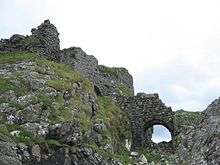Dunscaith Castle
Dunscaith Castle also known as Dun Scaich, Dun Sgathaich Castle and Tokavaig, is a ruined castle on the coast of the Isle of Skye, in the north-west of Scotland. It is located in the Parish of Sleat, in the Highland council area, and in the former county of Inverness-shire, at grid reference NG595120. Also called "Fortress of Shadows", it is named after and was the home of the warrior maiden Scáthach.[1][2] It is protected as a scheduled monument.[3]


History
The castle itself sits on an off-shore rock. The rock rises 40 feet above sea level and there is a gap of 20 feet between the rock and the mainland. The gap was once spanned by a walled bridge with arches 6 feet apart. This stone walled bridge then led onto a drawbridge, the pivot holes for which are still visible on the far side. Once on the other side of the drawbridge a door opened to a flight of stairs which was also sided by two walls. The flight of stairs led up to the castle.
Parts of the castle curtain wall still survive on the cliff edge but most of the inner buildings have gone. The curtain wall was about 5 ft thick. In the courtyard is a well and the remains of a stairway which once led up a tower.
Originally the castle belonged to the Clan MacDonald of Sleat, a branch of the Clan Donald or MacDonald. At some time in the 14th century it was taken from them by the Clan MacLeod and held briefly by the MacAskills, allies of the MacLeods but it was recaptured by the MacDonalds sometime in the 15th century.
In the 15th century the castle was again captured by King James I of Scotland when the Chief of the Clan Donald, Lord of the Isles was broken by King James I. The MacDonalds were allowed to keep possession of the castle. The MacDonalds abandoned the castle in the early 17th century.
Legend
The castle is featured in the Ulster Cycle of Irish mythology as the place where Scáthach the Shadow, legendary Scottish warrior woman and martial arts teacher, trained the hero Cú Chulainn in the arts of combat.[4] The Irish name for the fort, Dun Scathiag, was named after her.[5]
See also
Notes
- Whitley Stokes, ‘The Training of Cúchulainn’, Revue Celtique, 29 (1908), 109–52;
- "Sgàthaich" is "Scáthach" in the genitive case and Scottish Gaelic spelling
- Historic Environment Scotland. "Dun Scaich,castle,Tokavaig (SM954)". Retrieved 24 February 2019.
- "Scáthach." Encyclopædia Britannica. Encyclopædia Britannica Online Academic Edition. Encyclopædia Britannica Inc., 2014. Web. 03 Jun. 2014. <http://www.britannica.com/EBchecked/topic/526802/Scathach>.
- P. L. Henry, Celtica, 21 (1990), 191–207.
External links
- Castle of Shadows, Scáthach
- Dun Sgathaich Castle, Dark Isle
- Lieutenants of the Coast, MacAskill.com
- Dun Scaich, Royal Commission on the Ancient and Historical Monuments of Scotland
- The Misty Isle, Sgathaich
- The Red Branch, Timeless Myths
- Dun of the Shadow, Clan Donald